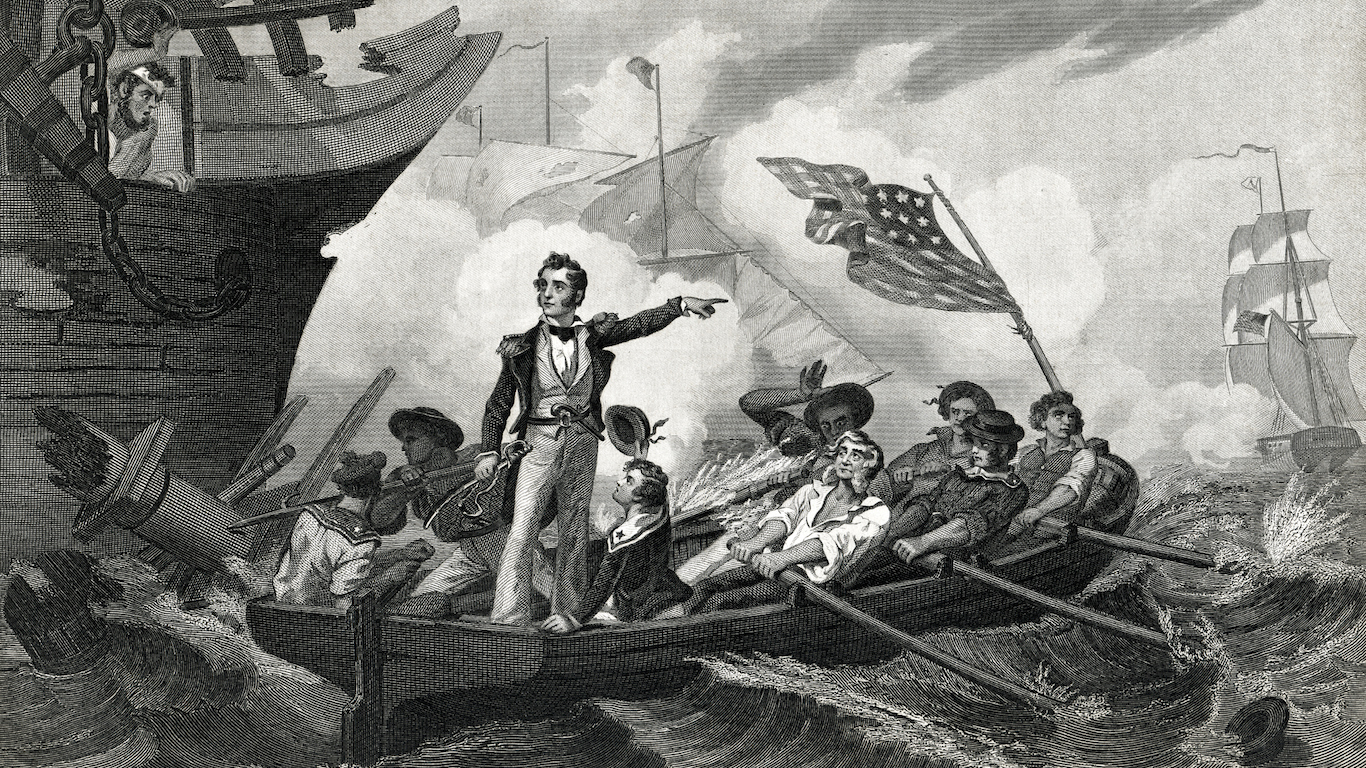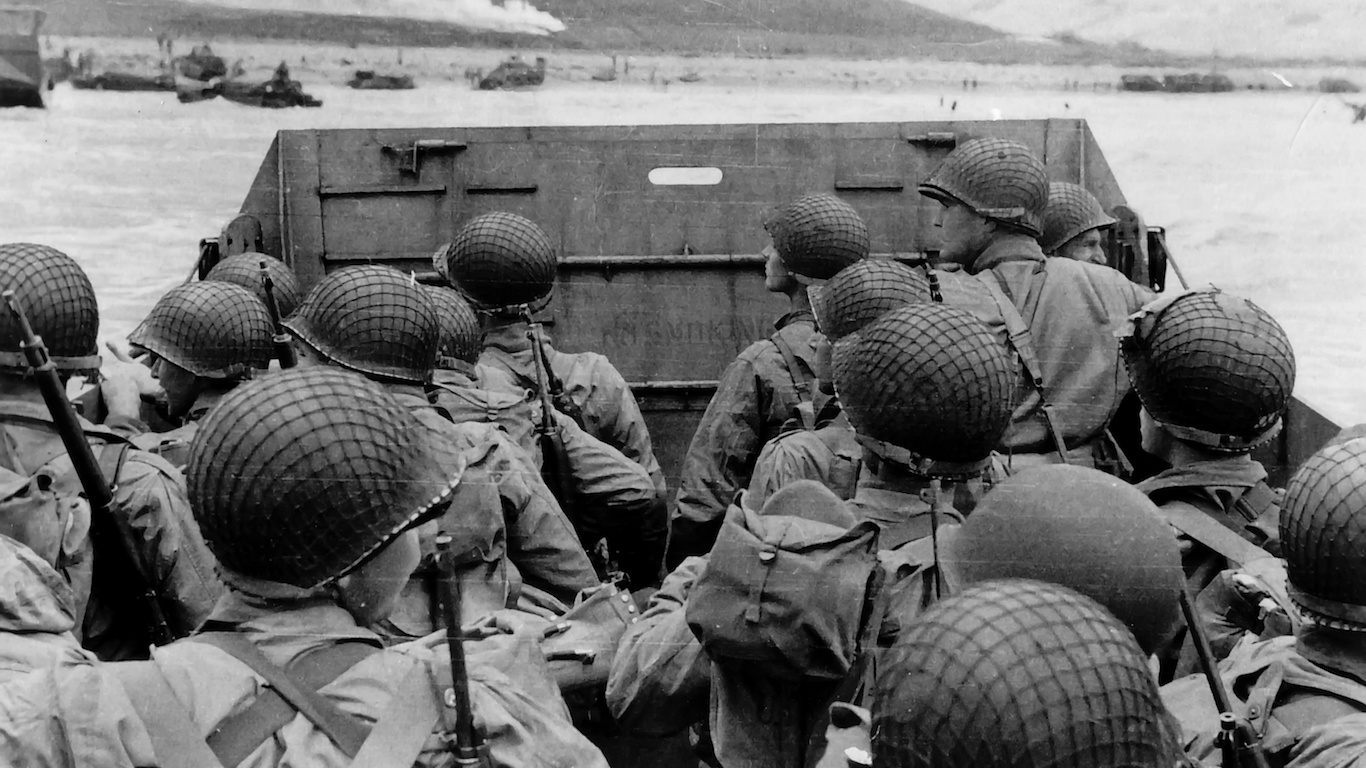Special Report
Most Expensive Wars in US History

Published:
Last Updated:

With the recent commemoration of the 75th anniversary of D-Day, we are reminded once again of the human cost of freedom and liberty. While some attempt to rank wars by the number of casualties, others would consider the social, environmental, and political upheaval that comes with sustained conflict. And of course, there is always the financial cost.
Many factors can affect the cost of waging war. To determine the most expensive wars in U.S. history, 24/7 Wall St. used a 2010 report from the Congressional Research Service titled “Costs of Major U.S. Wars.”
Click here to see the most expensive wars in U.S. history.
Click here to see our detailed findings and methodology.

13. War of 1812
> U.S. war spending (2019 dollars): $1.78 billion
> Duration: 2 years, 8 months
> U.S. military deaths: 15,000
The newly created American nation was in dispute with the British Empire in the early 19th century. The United States claimed the British were trying to limit trade and were forcing U.S. sailors to serve in the Royal Navy, grievances related to Britain’s war with France. The United States also had ambitions to expand into British-controlled Canada. The U.S. was rebuffed in its invasion of Canada and suffered other defeats, including the capture and burning of Washington, D.C. Even so, the United States withstood a British naval bombardment at military installations in Baltimore and defeated the British in New Orleans. The Treaty of Ghent ended the nearly three-year-long war, with the United States retaining its sovereignty, but America was prevented from expanding northward into Canada. The war was the first of five declared wars by the United States. The War of 1812 cost the nation $1.78 billion. About 15,000 Americans died in the war from battlefield wounds and disease.
[in-text-ad]

12. Mexican-American War
> U.S. war spending (2019 dollars): $2.72 billion
> Duration: 1 year, 9 months
> U.S. military deaths: 13,283
Fought between 1846 and the start of 1848, the Mexican-American War cost the United States $2.72 billion, the 11th-most expensive war in U.S. history. The bone of contention was Texas, which had gained independence from Mexico a decade earlier. Texas had not yet been incorporated into the United States because its inclusion would have upset the equilibrium between slave and free states established by the Missouri Compromise of 1820. Skirmishes along the Rio Grande led to clashes such as the Battle of Palo Alto that resulted in American victories. The war ended on Feb. 2, 1848, with the Treaty of Guadalupe-Hidalgo. The accord established the Rio Grande as the southern border of Texas and the U.S. gained land in present-day California, Utah, Nevada, Arizona, and New Mexico.

11. American Revolution
> U.S. war spending (2019 dollars): $2.75 billion
> Duration: 8 years, 5 months
> U.S. military deaths: 4,435
The eight-year quest for independence cost the American colonies just over $2.75 billion and about 4,400 lives. While the war began as a revolt against unjust taxation, it ended with the colonies and their allies defeating the British Empire and the Founding Fathers rejecting the social and political structures of Europe in favor of a republic. The Treaty of Paris ended the war in 1783, officially recognizing the United States as an independent country and establishing its borders.

10. Spanish-American War
> U.S. war spending (2019 dollars): $10.33 billion
> Duration: 4 months
> U.S. military deaths: 2,446
Often considered the first media war, sensationalized journalism helped fuel support for America’s involvement in the Cuban quest for independence from Spain. When the USS Maine, which had been sent to Havana to protect American interests, unexpectedly blew up in 1898, cries for American intervention increased. Congress officially declared war under the context of the Monroe Doctrine, which forbade European interference in the Western Hemisphere. U.S. forces crushed Spanish forces worldwide. The war cost $10.33 billion, and the U.S. gained the Pacific island of Guam, Puerto Rico, and the Philippines. As a result of the war, America emerged as a global power.
[in-text-ad]

9. American Civil War (Confederacy)
> U.S. war spending (2019 dollars): $22.99 billion
> Duration: 4 years
> U.S. military deaths: 750,000 (North and South)
The Civil War claimed 750,000 American lives, North and South, more than any other U.S. conflict. The war was fought primarily over the issues of slavery and states’ rights, and it took place primarily in the South. The conflict began after South Carolina seceded from the Union in 1861. The war laid waste to most of the South and left the region devastated for years. In addition to famous battles like Antietam, Bull Run, and Gettysburg, there was guerrilla warfare in border states and areas of conflict that involved the civilian population. The Civil War ended the plantation system and the institution of slavery in the South. It cost Confederate states $22.99 billion in their failed attempt to secede from the Union.

8. American Civil War (Union)
> U.S. war spending (2019 dollars): $68.17 billion
> Duration: 4 years
> U.S. military deaths: 750,000 (North and South)
For decades, the long-accepted death toll of the Civil War had been about 620,000. But a study published in 2011 by historian J. David Hacker raised that total to 750,000 lives, the highest by far of any U.S. conflict. The war, which began in 1861, was fought over the issues of slavery and states’ rights. Confederate General Robert E. Lee surrendered to Union General Ulysses S. Grant at Appomattox Court House, Virginia, four years later. By that time, the war to keep the United States united and abolish slavery had cost the Union $68.17 billion.

7. Persian Gulf War
> U.S. war spending (2019 dollars): $116.6 billion
> Duration: 7 months
> U.S. military deaths: 383
The Persian Gulf War, one of the shortest conflicts in U.S. history, cost $116.6 billion, or just 0.3% of U.S. GDP in 1991. Tensions mounted in the Middle East when Iraqi dictator Saddam Hussein invaded Kuwait in August 1990. Despite calls from the United Nations for Iraq to withdraw, Hussein refused. A few months later, a massive U.S.-led coalition that included NATO allies and Middle East nations such as Egypt and Saudi Arabia initiated Operation Desert Storm. The offensive lasted just 42 days and ended in catastrophe for Iraq in February 1991. Hussein agreed to recognize Kuwait’s sovereignty and destroy his stores of weapons of mass destruction, such as nuclear, biological, and chemical weapons. However, Hussein remained in power. As the first major conflict after the Cold War, the Persian Gulf War was, at the time, heralded as a success for the international coalition.
[in-text-ad]

6. World War I
> U.S. war spending (2019 dollars): $381.8 billion
> Duration: 1 year, 7 months
> U.S. military deaths: 116,516
War broke out in Europe in 1914, but the United States remained neutral for the next three years. American financial institutions prospered by lending money to the combatants, mostly France and Great Britain. However, the United States was gradually pulled into the conflict mostly because of Germany’s use of unrestricted submarine warfare against all ships bound for the nations it was fighting. When British intelligence revealed a communication from German diplomats to Mexican envoys that proposed an alliance between the two countries if the United States entered the war against Germany, America was compelled to act. The United States declared war on Germany on April 2, 1917. World War I ended 19 months later, costing the lives of more than 116,000 troops. Ultimately, the conflict cost the United States $381.8 billion.

5. Korean War
> U.S. war spending (2019 dollars): $389.81 billion
> Duration: 3 years, 1 month
> U.S. military deaths: 36,574
In June 1950, the North Korean military, supported by the Soviet Union, crossed the 38th parallel that divided North and South Korea. That began the Korean War. Fearful of the spread of communism, President Harry Truman garnered support from the United Nations Security Council to expel North Korean troops from the South. General Douglas MacArthur, however, pursued the North Koreans to the Yalu River, which formed the northern border between China and the Korean peninsula. The Chinese interpreted MacArthur’s actions as an act of war and entered the conflict, driving U.N. troops down the peninsula. The war eventually ended after Dwight Eisenhower became president and threatened the use of nuclear weapons if the North Koreans or Chinese did not respect the 38th parallel as the boundary between the two countries. Ultimately, the Korean War cost the United States $389.81 billion and about 36,000 lives.

4. Vietnam War
> U.S. war spending (2019 dollars): $843.63 billion
> Duration: 17 years, 9 months
> U.S. military deaths: 58,220
The war in Vietnam cost the United States $843.63 billion in 2019 dollars, or 2.3% of GDP in 1968. By the end of the conflict, the names of more than 58,000 dead soldiers were recorded on the Vietnam Veterans Memorial in Washington, D.C. After the Vietnamese defeated the French in 1954, ending a brutal era of colonialism, the Geneva Accords stipulated that elections in the South be scheduled for the following year. Determined not to let communism spread, the U.S. lent its support to Ngo Dinh Diem, a French-educated, Catholic politician in South Vietnam. By the time the U.S. committed troops in 1965, Diem had been assassinated and Vietnamese support for the new military-led South Vietnamese government had faded. With supplies from China and the Soviet Union, North Vietnam primarily used guerrilla tactics to attack U.S. troops and bases. By the late 1960s, public support for the war in the U.S. was waning. American troops withdrew in 1973 and South Vietnam fell to communist North Vietnam in 1975.
[in-text-ad]

3. War in Afghanistan
> U.S. war spending (2019 dollars): $910.47 billion
> Duration: Since 2001
> U.S. military deaths: 2,285
The United States has been embroiled in an ongoing battle in Afghanistan since 2001. Following the terrorist attacks on Sept. 11, 2001, the United States invaded the central Asian nation in order to drive out the ruling Taliban, which provided al-Qaeda, the terrorist group responsible for the 9/11 terror attack, with safe haven. Yet in the over 17 years since the war began, the U.S. military has so far been unable to establish Afghanistan as a stable, safe place. The War in Afghanistan is now the only war in U.S. military history to have three commanders in chief preside over the conflict. From President George W. Bush to Barack Obama and now Donald Trump, none could find a way to bring the extended conflict to an end. As the war drags on, military spending on this war will continue to accumulate.

2. Iraq War
> U.S. war spending (2019 dollars): $1.01 trillion
> Duration: 7 years, 5 months
> U.S. military deaths: 4,410
The conflict in Iraq has cost the United States about $1 trillion. Believing he had weapons of mass destruction, U.S. troops invaded Iraq in 2003 and overthrew Saddam Hussein. The U.S. government considers elections in Iraq, as well as training military personnel to help stabilize the region, as successes. Even so, the country continues to be marred by conflict and terror.

1. World War II
> U.S. war spending (2019 dollars): $4.69 trillion
> Duration: 3 years, 9 months
> U.S. military deaths: 405,399
The United States spent more than $4 trillion, or 36% of its GDP, fighting World War II. More than 400,000 U.S. troops were killed in the conflict to defeat Nazi Germany, Italy, and the Japanese Empire. U.S. involvement officially began on Dec. 8, 1941, the day after the Japanese bombed Pearl Harbor. America officially declared war against Germany and Italy three days later, after Germany and Italy had declared war on the United States. After conquering most of Europe, Germany attacked the Soviet Union. The Soviet Union bore most of the ground conflict with Germany before the United States and its allies opened the Western front in 1944. The European war ended in May 1945, and Japan surrendered after the United States dropped nuclear bombs on Hiroshima and Nagasaki in August of that year. The United States and the Soviet Union emerged from World War II as the world’s biggest superpowers and became rivals in the Cold War.
Detailed Findings & Methodology
World War II remains as the costliest conflict in American history, accounting for nearly 36% of the country’s gross domestic product in 1945, or $4.7 trillion based on inflation-adjusted constant dollars. More recently, the wars in Iraq and Afghanistan rank as the second- and third- most expensive conflicts in American history, respectively. The war in Afghanistan is the longest in U.S. history, nearly 18 years and counting, though it is not among the longest wars in history.
Many early wars in U.S. history resulted in the United States gaining more land and territories. The Mexican-American War in the 1840s yielded much of the territory that makes up the present-day Southwest. Similarly, the Spanish-American War at the end of the 19th century ended with the United States controlling the Pacific island of Guam, Puerto Rico, and the Philippines. The results of these wars and others led to the United States establishing large military bases around the world.
In every conflict before World War II, nearly all of the country’s defense budget was spent on direct conflict — classified as wartime spending. For example, the United States spent 1.1% of its GDP in 1899 to fight the Spanish-American War, nearly its entire defense budget of 1.5% of GDP.
That trend largely changed at the start of the Cold War. Because of the persistent threat of military conflict, the United States had to be ready for war at any time. This led to the space race and nuclear armament becoming national priorities. As a result, wartime spending and defense spending began to diverge. During the Korean War, for example, war spending accounted for 4.2% of GDP in 1952, while total defense spending accounted for more than 13% of GDP. At $649 billion in 2018, America spent the most on war of any country.
Comparing the costs of war over a period of almost 250 years can be difficult. While the report attempts to correct for inflation by calculating each war’s cost in fiscal year 2018 dollars, inflation adjustments do not account for advances in technology. It is entirely possible that wars also became more expensive over time as the sophistication and use of technology increased. A byproduct of the production of war materials was the creation of commercial products invented by the military.
Spending on the war in Afghanistan has been updated through 2017. Because exact spending figures for each year following 2014 were not available but the total spending until 2017 was, we assumed equal spending on the war in the years 2015, 2016, and 2017, and adjusted each figure according to that year’s Defense Spending deflator that is pegged to 2019 dollars. Inflation price indexes used in this adjustment are from the U.S. Office of Management and Budget. The CRS report does not include veterans’ benefits, interest on loans used to finance the war, and assistance to allies.
Credit card companies are at war. The biggest issuers are handing out free rewards and benefits to win the best customers.
It’s possible to find cards paying unlimited 1.5%, 2%, and even more today. That’s free money for qualified borrowers, and the type of thing that would be crazy to pass up. Those rewards can add up to thousands of dollars every year in free money, and include other benefits as well.
We’ve assembled some of the best credit cards for users today. Don’t miss these offers because they won’t be this good forever.
Flywheel Publishing has partnered with CardRatings for our coverage of credit card products. Flywheel Publishing and CardRatings may receive a commission from card issuers.
Thank you for reading! Have some feedback for us?
Contact the 24/7 Wall St. editorial team.